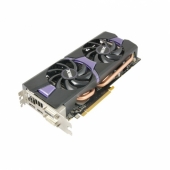Sapphire R9 285 Dual X Video Card Review
 |
So What Is Tonga?
We’ve taken a look at AMD’s top offering, the 290X, which utilizes the Hawaii architecture and puts up some impressive benchmark results. Shortly after we reviewed the R9 280 which is on the last-gen Tahiti architecture and, while still a very viable card for today’s games, didn’t bring anything new to the table. But now AMD has come out with a new “in-between” architecture code named Tonga that could prove to be impressive.
Although the spec sheets are very similar, Tonga is not a spin-off of Tahiti, but rather a modified and scaled-down version of the 290/290X’s Hawaii core. It gets the improved tessellation and GPU compute performance as well as Crossfire operation without a bridge connector found in the Hawaii cards.
 |
A glaring downgrade found in this card though is the 256-bit memory bus which is down 33% from Tahiti’s 384-bit bus. AMD claims this difference is more than made up by dramatically increased memory bandwidth efficiency, though the benchmarks will make the final decision on that.
Today we are taking a look at the Sapphire R9 285 Dual-X specifically. Along with the architecture enhancements, this 285 also sports Sapphire’s tried and true dual-fan heat-pipe based cooler. With Tonga’s lower power draw combined with a quality cooler, we can expect some low temps, quiet operation, and plenty of overclocking headroom. Read on to see how it performs.
 |

[…] Sapphire R9 285 Dual-X OC Video Card Review @ TechwareLabs.com […]
[…] TechwareLabs comes back with the Sapphire R9 285 Dual-X OC Video Card […]
[…] Sapphire R9 285 Dual-X OC Video Card Review @ TechwareLabs.com […]
[…] Sapphire R9 285 Dual-X OC Video Card Review @ TechwareLabs.com […]